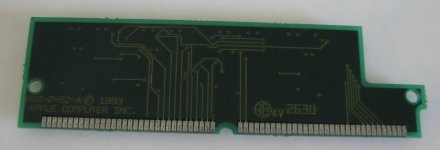I've been playing with various ROM hacking stuff on the II series Macs, and I found this on eBay and couldn't resist snatching it up. It's a really weird shape!


Googling for the part number 820-0482-A seems to find a few results implying it's a 64-pin ROM SIMM belonging to a Quadra 840av. Further Googling is showing that some (few?) 840av models have the SIMM socket, but others (most?) have soldered ROM. I have an 840av, but haven't had a chance to check if mine has the ROM SIMM socket (and if there are clearance issues explaining why the SIMM is such an odd shape). Also, since the 660av and 840av share the same ROM, it might be for a 660av instead.
Can anybody confirm that this is for an 840av? I'm tempted to figure out a way to dump the contents to see for sure. I wonder if it is identical to the ROM version that is soldered on with later models?
I've been using a continuity tester and the JEDEC standard for 32-pin PLCC chips to figure out its pinout. The pinout is ALMOST identical to the II series ROM SIMM pinout, except the chip enable line on the four chips is directly connected to GROUND (always active) on this SIMM, and the SIMM pin that was used for chip enable on the II series is now another VCC pin.


Googling for the part number 820-0482-A seems to find a few results implying it's a 64-pin ROM SIMM belonging to a Quadra 840av. Further Googling is showing that some (few?) 840av models have the SIMM socket, but others (most?) have soldered ROM. I have an 840av, but haven't had a chance to check if mine has the ROM SIMM socket (and if there are clearance issues explaining why the SIMM is such an odd shape). Also, since the 660av and 840av share the same ROM, it might be for a 660av instead.
Can anybody confirm that this is for an 840av? I'm tempted to figure out a way to dump the contents to see for sure. I wonder if it is identical to the ROM version that is soldered on with later models?
I've been using a continuity tester and the JEDEC standard for 32-pin PLCC chips to figure out its pinout. The pinout is ALMOST identical to the II series ROM SIMM pinout, except the chip enable line on the four chips is directly connected to GROUND (always active) on this SIMM, and the SIMM pin that was used for chip enable on the II series is now another VCC pin.
